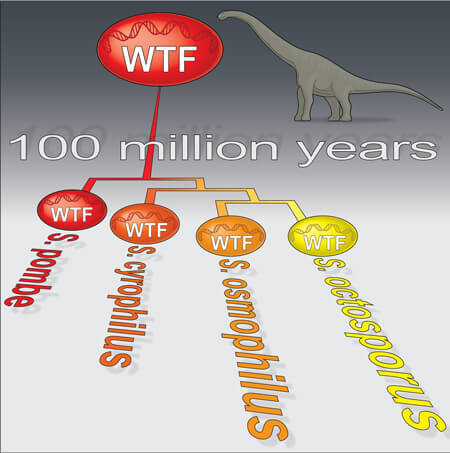Genomes generally evolved law enforcement for these heinous genes,
helping to make their criminal sprees short-lived from an evolutionary
timespan. Suppressor genes evolve to stop driver transmission for the
good of the species. Drivers that manage to outrun suppressors can
spread to all members of the population (fixation). This too stops
driver genes as they decay when there are no longer competing alleles
they can “cheat.”
“What makes this finding so interesting is that this family of drive
genes have persisted at least ten times longer than what was thought
possible,” said SaraH Zanders, Ph.D., an associate investigator at the Stowers Institute.
However, in a recent study published in eLife on
October 13, 2022, led by Predoctoral Researchers Mickael De Carvalho,
Ph.D., from the Zanders Lab, and Guo-Song Jia from the lab of Li-Lin Du,
Ph.D., discovered that the killer meiotic gene family, wtf, in the fission yeast, Schizosaccharomyces pombe,
are also present in three different fission yeast species, having
managed to evade local, federal, international, and Darwinian law
enforcement for over 100 million years.
Fission yeast divides into two cells via splitting down its
rod-shaped center and is an excellent research organism for studying
sexual reproduction and genetics. Fission yeast can also mate with each
other, producing a diploid cell that undergoes meiosis to yield four
spores, yeast’s analog to sperm or egg cells in humans.
All extant yeast species shared a common ancestor around 220 million
years ago. Comprehensive evolutionary analyses of all living species
reveal compelling and novel evidence that wtf meiotic drivers
were born about 100 million years later and have been causing drive for
the last 119 million years. Specifically, the wtf meiotic drivers are still present in four living species—S. pombe, S. octosporus, S. osmophilus, and S. cryophilus—and are actively causing drive in at least two, S. pombe and S. octosporus.
Wtf, the rather impertinent name for these genes stands for with transposon fission
and is derived from the genes’ association with long strands of
repetitive DNA sequences (transposons) that can easily change locations
within a genome. In this highly mutable gene family, drivers and
suppressors are likely constantly at war, each rapidly evolving to
outsmart the other; wtfs always manage to stay one step ahead of Darwinian law enforcement, hence their genetic persistence.
“This changes the way we look for these types of genes,” said
Zanders. “Before now, I would never have thought to look for novel
drivers in old, evolutionarily conserved candidate genes.”
How these meiotic drivers have managed to outrun extinction is not
only due to the difficulty for suppressors to keep up with rapidly
evolving wtf drivers. In all four fission yeast species, the researchers found that wtf genes
are present in massive numbers of copies throughout their respective
genomes, with the number of potential drivers ranging between 5 and 83,
species-dependent.
A model for the evolutionary complexity of wtfs proposes that long-term persistence is driven by a continuous cycle of death and rebirth allowing wtf genes
to short-circuit suppression and fixation. In addition, despite their
reputation as genetic parasites, meiotic drive systems are major
propellors of genome evolution.
“The idea that they can exist for long periods of time suggests that
their impact on shaping the genome is also long-lived,” said Zanders.
Even among scientists, it is not widely understood or appreciated
that not all pieces of a genome are beneficial. The notion that natural
selection will always eliminate genes that are detrimental may in fact
be a very narrow understanding of how evolution works.
“What we are seeing is that “bad stuff” in a genome can flourish,
which is very satisfying given how many times I’ve been “corrected” on
my understanding of evolution,” said Zanders. “I think this is an
excellent example of natural selection’s limitations.”
Additional authors include Ananya Nidamangala Srinivasa, R. Blake
Billmyre, Ph.D., Jeffery J. Lange, Ph.D., and Ibrahim M. Sabbarini.
This
work was funded by the New Innovator Award of the National Institutes
of Health (award: DP2GM132936), institutional support from the Stowers
Institute for Medical Research, the Chinese Ministry of Science and
Technology, and the Beijing Municipal Government. The content is solely
the responsibility of the authors and does not necessarily represent the
official views of the NIH.






